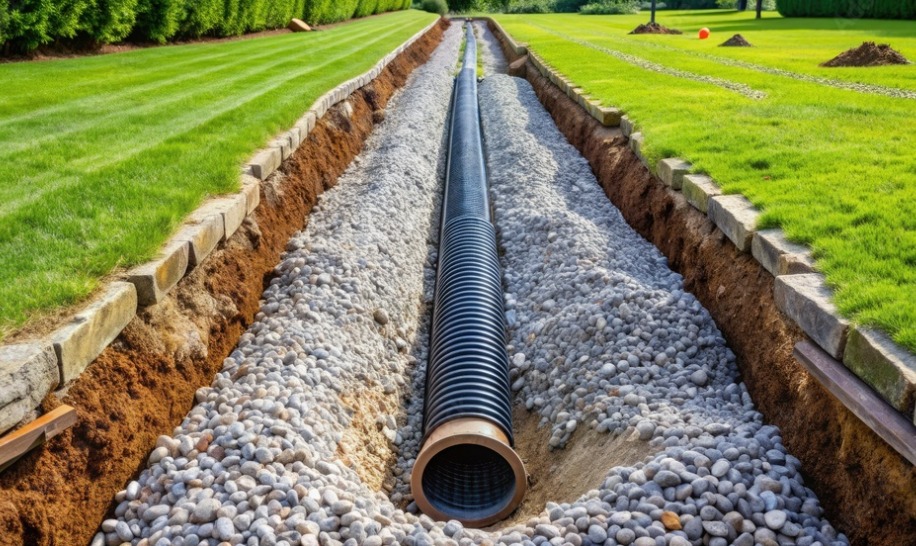What Are the Different Types of French Drain?

French drains come in several types.
They're designed to solve specific water problems.
They got their name from Henry French, who wrote about these useful drainage systems in the 1800s.
His book helped many landowners improve their property's water management.
Here's an overview of the different types of French drains:
Traditional French Drain
The traditional French drain forms the basis for all variations and effectively manages water runoff and groundwater.
Characteristics:
- It consists of a perforated pipe surrounded by gravel or rock
- Typically installed in a sloped trench
- It can be used for both surface and subsurface drainage
Applications:
- General yard drainage
- Diverting water away from building foundations
- Managing excess water in landscapes
Curtain Drain (Interceptor Drain)
A curtain drain, also known as an interceptor drain, is designed to intercept water flowing through the ground before it reaches a problem area.
Characteristics:
- Installed across a slope or along the uphill side of a wet area
- Typically shallower than traditional French drains
- It often uses a perforated pipe wrapped in landscape fabric such as membranes.
Applications:
- Preventing water from flowing downhill into a specific area
- Protecting structures at the bottom of slopes
- Managing surface runoff on hillsides
Interior French Drain
An interior French drain is installed inside a building, typically in basements or crawl spaces, to manage water that has already entered the structure.
Characteristics:
- Installed along the inside perimeter of a basement floor or crawl space
- Often connected to a pumping station for water removal
- This may involve breaking up and replacing part of the concrete floor
Applications:
- Preventing basement flooding
- Managing moisture in crawl spaces
- Redirecting groundwater that seeps through foundation walls
Exterior French Drain
This type of French drain is installed around the outside perimeter of a building's foundation to protect against water damage.
Characteristics:
- Typically installed during construction, but can be retrofitted
- Often combined with waterproofing measures
- Directs water away from the foundation to a drainage point
Applications:
- Protecting home's foundation from water damage
- Preventing water intrusion into basements
- Managing groundwater around buildings
Trench Drain
Trench drain systems are effective solutions for surface drainage, sharing principles with French drains. These systems include channel drains, which we offer in various load ratings for residential to industrial applications.
While not always considered a proper French drain, trench drain systems have the following characteristics:
Characteristics:
- Linear drainage system, often with a grated surface
- It can be made of polymer concrete, fiber-reinforced plastic, or stainless steel
- Typically installed flush with the ground surface
Applications:
- Driveways and parking lots of commercial buildings
- Pool decks and patios
- Industrial areas with high surface water flow
Filter Drain
A filter drain is a variation of the French drain that includes additional filtration materials for improved water quality.
Characteristics:
- It uses layers of differently-sized aggregates around the perforated pipe
- For extra filtration, these systems can include a geotextile membrane or a filter sleeve wrapped around the drain like our land drain filter sleeve.
- Designed to remove pollutants from water as it drains
Applications:
- Road and highway drainage
- Environmental protection in industrial areas
- Locations where water quality is a concern
Dispersal French Drain
This type of French drain is designed to disperse water over a wide area rather than directing it to a specific point.
Characteristics:
- Often has no outlet pipe
- Distributes collected water into the surrounding soil
- It may be used in conjunction with soakaway crates or septic tanks
Applications:
- Areas where directing water to a specific point is not feasible
- Recharging groundwater
- Managing runoff in environmentally sensitive areas
Slope French Drain
Designed specifically for sloped landscapes to manage water runoff and prevent soil erosion.
Characteristics:
- Installed diagonally across a slope
- Often incorporates multiple branches or a herringbone pattern
- May include catch basins at key points
Applications:
- Hillside landscaping
- Erosion control on slopes
- Diverting water away from structures on sloped properties
French Drain with Sump Pump
This system combines a traditional French drain with a sump pump to remove water actively in areas with severe drainage problems.
Characteristics:
- Includes a sump pit where water collects
- Equipped with an electric pump to actively remove collected water
- Often consists of a battery backup system
Applications:
- Basements with persistent water issues
- Areas with high water tables
- Situations where gravity drainage alone is insufficient
Perimeter Drain
Perimeter drains are a specific type of French drain installed around the perimeter of a structure to provide comprehensive protection.
Characteristics:
- Installed around the entire perimeter of a building
- Often combined with a waterproofing system
- Can be installed during construction or retrofitted
Applications:
- Protecting home's foundation from water damage
- Preventing water intrusion in basements and crawl spaces
- Managing groundwater around buildings
Surface Water Drains
Surface water drains are designed to collect and redirect surface water runoff quickly.
Characteristics:
- Installed at ground level
- Often feature grates or catch basins to collect water
- Can be connected to underground drainage pipes
Applications:
- Driveways and parking areas
- Landscaped areas prone to water pooling
- Sports fields and recreational areas
Slot Drain
A slot drain is a narrow, linear drainage system that efficiently removes water with minimal visual impact.
Characteristics:
- Narrow opening at the surface
- It can be made of galvanised steel, stainless steel, or polypropylene. The bases could either be made from polymer concrete or polypropylene.
- Often used in areas where aesthetics are important
Applications:
- Commercial and residential properties
- Pool surrounds
- Industrial facilities requiring heavy-duty drainage
Threshold Drains
Threshold drains are specialised drainage systems designed to prevent water from entering a building at doorways or other thresholds.
Characteristics:
- Installed at the entrance of doorways, patio doors, or garage entrances
- Often consists of a narrow channel with a grate on top
- It can be connected to a larger drainage system or a French drain
- Made from durable materials like stainless steel or polymer concrete
Applications:
- Preventing water ingress at building entrances
- Managing runoff in areas with level transitions (e.g., from a patio to interior flooring)
- Protecting interiors from water damage in regions with heavy rainfall
- Enhancing accessibility by eliminating raised thresholds while still providing drainage
Wrapping It Up
These different types of French drain systems offer solutions for various drainage problems, from managing surface water and groundwater to protecting foundations and preventing soil erosion.
The choice of drain type depends on factors such as the specific area to be drained, the volume of water to be managed, soil conditions, and local regulations.
For complex drainage issues, it's advisable to seek expert advice to ensure the most effective drainage solution is implemented.



